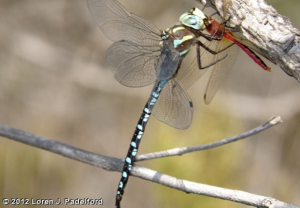Variable Darner Dragonfly: What Makes Them Good Predators?

Valerie Assinewe, Professional Writing Program Intern
Dragonflies have no sense of hearing, cannot smell, and are unable to vocalize. However, this has not limited their predator lifestyle. The two compound eyes which dominate the head are composed of 30000 facets, or lenses each. Each facet forms one visual information and together the lenses form a mosaic image. This visual system is extremely sensitive to movement, polarized light, and with the way the head is attached to the neck provides a 360-degree visual field. It gives this predator an advantage to target and intercept prey. It also means that with no blind spot they are hard to catch. 
Dragonflies are a fast and highly manoeuvrable hunter. Their four wings, which are extended horizontally, operate independently of each other, allowing it to move in mid-air like a helicopter—they can hover, fly forwards, backwards, and sideways, and instantly change direction whenever they need to. Dragonflies can even fly upside down if they need to. With the exception of damselflies (which belong to the same order), dragonflies are the only insects with this amount of control over their wings. Delicate yet powerful, each wing connects to the thorax with a separate muscle group. Bursts of 0.3 m/s have been recorded.
Dragonflies are in the order Odonata meaning “toothed ones.” Insects do not have teeth in the sense that mammals have teeth. The mouthparts are made of chitin, as is the rest of the exoskeleton. Nevertheless, the labrum (upper lip), labium (lower lip), mandibles, and maxillae are formidable capturing and eating machinery. Watching the jaw action of this predator, especially in its aquatic life stage, will show how this insect could have inspired the “Alien” movies. In as little as 1/100 of a second, the prey is secured by the labium, which can be extended out to 1/3 the length of nymph body, snagging the victim and delivering it to the waiting hungry jaws.
As an adult, the Darner will eat almost any soft-bodied flying insect including mosquitoes, flies, butterflies, moths, mayflies, stoneflies, and immature dragonflies. As a naiad, the Darner feeds on a wide variety of aquatic insects, such as mosquito larvae, other aquatic fly larvae, mayfly larvae, and freshwater shrimp. They will also eat very small fish and tadpoles. Dragonflies are voracious feeders and I for one am grateful they have remained small since their evolution millions of years ago.


